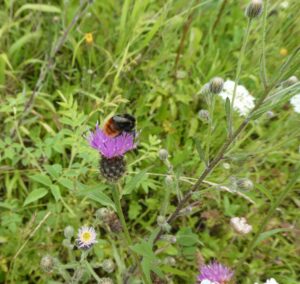
View from top field

 Dogwood berries Red tailed Bumble bee on Knapweed
Dogwood berries Red tailed Bumble bee on Knapweed
How the Halsey Field became a wildlife site, by DEF members Chris & Mike Ridley
As we wandered into the field, we saw an abundance of purple Orchids and Marbled White butterflies flitting from flower to flower. The more we looked, the more different species of wild flowers we spotted amongst the grasses; we couldn’t believe such variety existed almost on our doorstep! This was the start of our interest in the Halsey Field (the former playing field of the Halsey school), and our mission to try to protect the plants and creatures living there.
With a great deal of help and support from members of the Dacorum Environmental Forum (DEF), we persuaded Herts and Middlesex Wildlife Trust (HMWT) to do a wildlife survey on the area in July 2014. The site was found to support sufficient important species to be classed as a Local Wildlife Site and the HMWT wrote a report about the survey, which included a list of species found in the field, and a management plan.
However, as no one was managing the site at the time, it was becoming over-run with saplings of Ash, Hawthorn, Blackthorn and many more. In a couple more years it would have turned into secondary woodland, and much of the rich flora and fauna would have been lost. So DEF then approached Herts County Council, to seek permission to manage the field.
This was granted and since then, a group of dedicated volunteers, including some DEF members and a newly formed Friends of Halsey Field group, supported by the Chiltern Society and Hertfordshire Conservation Volunteers, have been working very hard to keep the scrub in check. Last November, the Osborne Property Group kindly agreed to hold their team-building day on the field, and cut down most of the remaining Ash trees, as well as helping to widen the main footpath.
Each Spring and Summer the field is ablaze with wildflowers, including red clover, many types of Vetch, Knapweed, Teasels and Bird’s foot trefoil, which attract over 20 species of butterfly and many varieties of bee and hoverfly.
 Ringlet on Ragwort
Ringlet on Ragwort
There are also some interesting bushes, such as Spindle, Wild Privet and Buckthorn, which provide nesting sites and food for birds, and shelter and egg laying opportunities for insects. Resident bird species include Dunnock, Wren, Song Thrush, Blackbirds, Green Woodpeckers, Blue, Great and Long-tailed tits and Kestrel, while Whitethroat and Chiff-chaff nest in the field and nearby wood in the summer months. Other birds, such as Willow Warbler, Bullfinch, Goldcrest and Siskin have been seen passing through the site.
The Friends of Halsey Field were successful in a bid for a grant from the Boxmoor Trust, and have therefore been able to buy some signage to explain some of the flora and fauna on the site, and buy some tools for its management.
If you would like to help with the Halsey field project in any way, either with the management (a free gym in the fresh air), or by taking a walk through the site and noting any interesting bird, butterfly or plant species, please contact me at: chrisridley57@gmail.com Management sessions usually run from 10am until approximately 1pm, but help for just part of the morning is very much appreciated. Free tea, coffee and cakes are provided, and the local Kestrel often comes to check us out during our break!
Otherwise just come for a walk and enjoy the site. Access is at the side of the garages on the bend of Fennycroft Road. The top part of the field is kept mown, but we are looking after the area from the top of the slope near the big oak tree, down to the fence at the bottom of the field.
Click here to see our promotion leaflet.
Halsey Field now has a Facebook page with photos and up-dates at: https://www.facebook.com/The-Halsey-Field-Local-Wildlife-Site-Hemel-Hempstead-1106523336038066/?ref=ts&fref=ts
A podcast about the discovery and importance of this Wildlife Site can be found at:
https://soundcloud.com/dgc_podcast/dgc-episode-12-halsey-field
